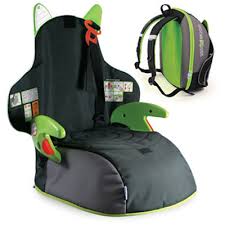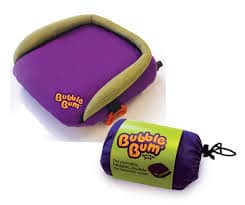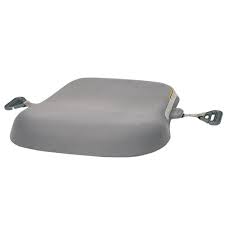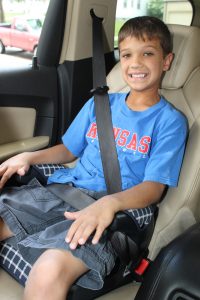Chances are you’ve heard of a booster seat. You know, the one that parents love because it’s super easy? The trouble is, many people are using them too soon, or letting their children out of them too soon, or not using them at all.
The purpose of a booster seat is in the name- it literally boosts a child up so that they can fit a seat belt, which is made for an adult. The problem with moving a child into a booster seat too soon is that they are not as good at protecting children as a car seat with a 5-point-harness. 5-point-harness systems distribute crash forces over a larger portion of the body than a seat belt does, therefore reducing the chance of injury. This isn’t to say that the seat belt is not safe, of course, but simply that car seats are so much safer. It is important to use a car seat until a child reaches the upper weight or height limits of their car seat. Once they have outgrown it, then a child is ready for the booster.
A common question that we get is to ask when a child should be in a high back booster versus a no back booster. The answer is: It depends!
High Back vs No Back Child Booster Seats
High back boosters often add extra protection to a child’s torso and head, especially in a side impact crash. They are also convenient if a child is prone to falling asleep in the car because it holds the child upright and within the seat belt. High back boosters are often necessary when the vehicle seat doesn’t have a head restraint because the child’s head could hyper extent backward. (Think of a truck back seat with no head restraint and only a window behind the seat. Ouch!)
No back boosters and incredibly convenient, especially if a child is changing vehicles often, such as carpooling. These types of boosters are still doing their job of boosting a child to fit the seat belt, so they are perfectly safe as long as a child uses it correctly. Like the picture above, all boosters must have the seat belt across the chest and shoulder, not behind the back or under the arm. Moving the location of the shoulder belt can cause serious injuries to a child’s internal organs. If a child is not mature enough to keep the shoulder belt in position, it may be better for a child to use a high back booster with a shoulder guide to keep it in place. As with all car seats and boosters, it is important to follow manufacturer’s instructors as printed on the sides of the seats and in the manual that comes with it. And just like car seats, booster seats have weight and height limits. Once your child has outgrown the booster, or you think they are ready for the seat belt, it’s important to follow the Seat Belt Fit Test.
Safe and Convenient Child Booster Seats Great for Traveling
Because boosters are an important step in protecting children in crashes, many boosters have been created to help children be safe while still being convenient! Two examples include: the Boost-A-Pak and the Bubble Bum. Whether traveling for the holidays or looking for easy transition for carpooling, both of these booster seats meet Federal Motor Vehicle Safety Standards! Another potential downside to using a booster as long as necessary, is an older child still feeling “little.” The Incognito is also approved and gives older kids just a small boost to fit the seatbelt properly while blending in with the car and being less conspicuous.

Easy to carry along when you are traveling the Boost-a-Pac is a great option for a child booster seat on the go!

Inflatable so it takes up little space the Bubble Bum is easy to pack in your luggage and use when you arrive!

Perfect for kids who think they are too old for a child booster seat the Incognito give a little boost and blends in easily with your car’s regular seats.
How to Tell if Your Child is Ready to Stop Using a Child Booster Seat
Kansas and Oklahoma law states that a child can stop using a car seat or booster once they are 8 years old, 80lbs., or 4’9”. This is an “or” statement, which means, by law, as long as a child has reached one of these measures, they are legally allowed to use the seat belt alone. However, not all 8 year olds are the same size, and not all 80 pound children are actually tall enough for the seat belt. For this reason, it is recommended that parents and caregivers use the Seat Belt Fit Test to ensure their children are ready for the seat belt. Ask the child to sit in the vehicle seat with their back and bottom against the back of the vehicle seat, buckle the seat belt, and check for these 5 things:
- The shoulder belt sits across their shoulder chest.
- The lap belt sits low on their hips/upper thighs.
- The knees should be at a 90-degree angle over the edge of the front of the vehicle seat.
- Their feet should be flat on the floor.
- The child should be able to sit in this way for the entire trip.
If the answer to each of these is “yes,” then they are ready for the seat belt. If any one of them is no, they likely still need the booster. It is important to note that a child may pass the seat belt fit test in one car, but not another. SUVs, vans, and trucks often have larger vehicle seats than sedans.
Booster seats are a very important step in child passenger safety, so using them correctly is just as important as any of the other car seats. If you would like more information, you can visit the Kansas Traffic Safety Resource Office website at www.ktsro.org/child-passenger-safety or find a local car seat technician who can help to make sure you have your car seat and boosters installed properly, and even help perform the Seat Belt Fit Test by clicking on “Kansas Car Seat Inspection Stations.”
Knowing the importance of a booster seat and finding one to fit your child and their lifestyle, you can now ensure your child is safe in the car every trip, every time.
Buckle Up. Every Trip. Every Time.
